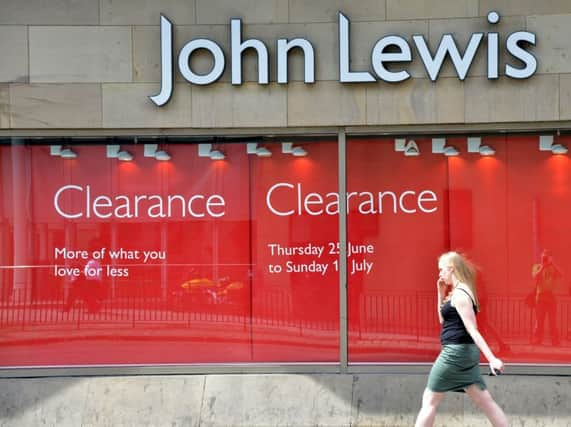Pension and price war to hit profits at John Lewis


The employee-owned department stores and supermarkets group said it expects pensions charges for the full year would be about £60 million higher than a year ago due to “volatility” in the markets.
Sir Charlie Mayfield, the firm’s chairman, said: “In the current market, even a strong trading performance is unlikely to offset this fully.”
Advertisement
Hide AdAdvertisement
Hide AdAs a result, annual pre-tax profits, before the costs of its partnership bonus scheme, are expected to come in at between £270m and £320m – down from £342.7m last year.
The guidance came as John Lewis, which has 44 department stores and 340 Waitrose supermarkets, posted a 26 per cent slide in pre-tax profits to £96m for the six months to 1 August, despite total sales growing 2.1 per cent to £5.1 billion.
Mayfield said the fall was mainly down to gains last year from property sales and higher pension costs, which ballooned by £29m, or almost 26 per cent, to £140.9m in the first half.
The company has been increasing contributions to its pension scheme to tackle a £1.12 billion deficit, which has shrunk by 7.4 per cent or £92.9m since the start of the year.
Stripping out the charges and one-off boosts from property disposals, Mayfield said trading profits were “broadly level” on a year ago, “despite the turmoil in the grocery market”.
With Waitrose coming under pressure amid the supermarket price war, sparked by the rising popularity of cut-price rivals such as Aldi and Lidl, like-for-like sales at the upmarket grocer fell 1.3 per cent.
However, latest industry data from researcher Kantar Worldpanel shows its sales rose by 3.7 per cent in the 12 weeks to 16 August, helping its market share lift to 5.1 per cent, up from 4.9 per cent a year earlier.
Aldi and Lidl both enjoyed double-digit gains, while Sainsbury’s was the only “big four” grocer to grow its takings, albeit by just 0.1 per cent.
Advertisement
Hide AdAdvertisement
Hide AdMayfield said: “Conditions in the market will remain difficult, especially in grocery where there is little sign of any price inflation. However, I expect sales in both Waitrose and John Lewis to perform comparatively well against the market, helped by promising new ranges and online capability.”
Like-for-like sales at John Lewis rose 3 per cent in the first half, while its online arm grew its gross takings by 17.1 per cent.
Julie Palmer, partner at business turnaround specialists Begbies Traynor, said it has been a “difficult summer” for the partnership, adding that the results “suggest wider concerns, with a slump in profits reflective of harsher trading conditions and higher pension charges”.
“Waitrose’s poor sales performance has shown that it is not immune to the vicious price war dominating the sector,” she said.